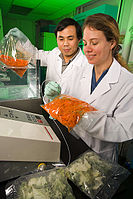
Radio frequency processing and recent advances on thawing and tempering of frozen food products.
Sign Up to like & getrecommendations! Published in 2020 at "Critical reviews in food science and nutrition"
DOI: 10.1080/10408398.2020.1823815
Abstract: During radio frequency (RF) thawing-tempering (defrosting) of frozen food products, some regions, mostly along the corners and edges, heat-thaw first due to the strong interaction of electric field and evolved heating leading to temperature increase.… read more here.
Keywords: food products; radio frequency; thawing tempering; frozen food ... See more keywords

Structure and application of antifreeze proteins from Antarctic bacteria
Sign Up to like & getrecommendations! Published in 2017 at "Microbial Cell Factories"
DOI: 10.1186/s12934-017-0737-2
Abstract: BackgroundAntifreeze proteins (AFPs) production is a survival strategy of psychrophiles in ice. These proteins have potential in frozen food industry avoiding the damage in the structure of animal or vegetal foods. Moreover, there is not… read more here.
Keywords: afps ice; water; structure; frozen food ... See more keywords

Development of loop-mediated isothermal amplification-lateral flow dipstick as a rapid screening test for detecting Listeria monocytogenes in frozen food products using a specific region on the ferrous iron transport protein B gene
Sign Up to like & getrecommendations! Published in 2022 at "Veterinary World"
DOI: 10.14202/vetworld.2022.590-601
Abstract: Background and Aim: Listeria monocytogenes is a critical foodborne pathogen that infects pregnant females and their newborns and older adults and individuals with comorbidities. It contaminates fresh vegetables, fruits, ready-to-eat foods, and frozen food products… read more here.
Keywords: lamp; food; lamp lfd; food products ... See more keywords

Safety and health risks for workers exposed to cold thermal environments: A frozen food processing industry perspective.
Sign Up to like & getrecommendations! Published in 2021 at "Work"
DOI: 10.3233/wor-213600
Abstract: BACKGROUND Environmental temperatures in the fresh food industry vary from 0°C to 10°C, and go below -20°C for the frozen food industry, representing risk for the health and safety of workers involved. OBJECTIVE The aim… read more here.
Keywords: temperature; industry; cold thermal; health ... See more keywords

Evaluation of the Suitability of Poly(Lactide)/Poly(Butylene-Adipate-co-Terephthalate) Blown Films for Chilled and Frozen Food Packaging Applications
Sign Up to like & getrecommendations! Published in 2020 at "Polymers"
DOI: 10.3390/polym12040804
Abstract: The use of biopolymers can reduce the environmental impact generated by plastic materials. Among biopolymers, blends made of poly(lactide) (PLA) and poly(butylene-adipate-co-terephthalate) (PBAT) prove to have adequate performances for food packaging applications. Therefore, the present… read more here.
Keywords: food packaging; poly lactide; packaging applications; frozen food ... See more keywords